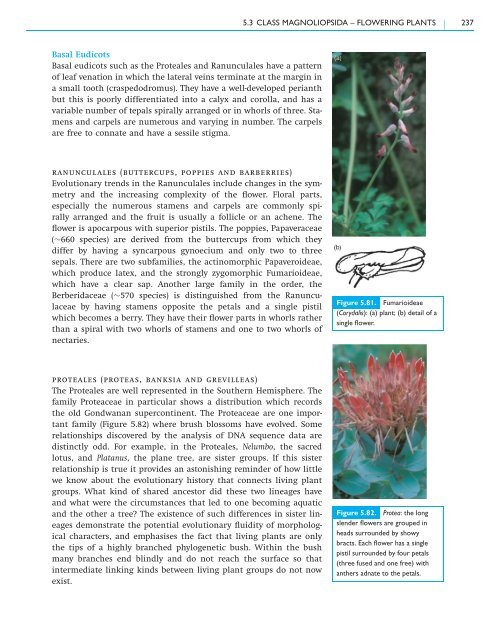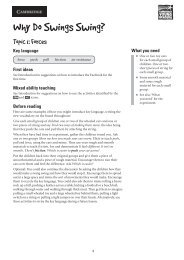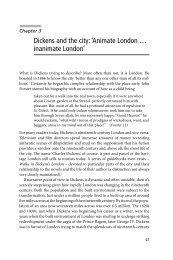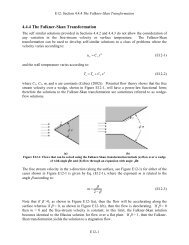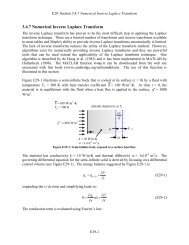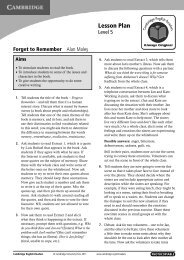5.3 Class Magnoliopsida – flowering plants - Cambridge University ...
5.3 Class Magnoliopsida – flowering plants - Cambridge University ...
5.3 Class Magnoliopsida – flowering plants - Cambridge University ...
You also want an ePaper? Increase the reach of your titles
YUMPU automatically turns print PDFs into web optimized ePapers that Google loves.
Basal Eudicots<br />
Basal eudicots such as the Proteales and Ranunculales have a pattern<br />
of leaf venation in which the lateral veins terminate at the margin in<br />
a small tooth (craspedodromus). They have a well-developed perianth<br />
but this is poorly differentiated into a calyx and corolla, and has a<br />
variable number of tepals spirally arranged or in whorls of three. Stamens<br />
and carpels are numerous and varying in number. The carpels<br />
are free to connate and have a sessile stigma.<br />
ranunculales (buttercups, poppies and barberries)<br />
Evolutionary trends in the Ranunculales include changes in the symmetry<br />
and the increasing complexity of the flower. Floral parts,<br />
especially the numerous stamens and carpels are commonly spirally<br />
arranged and the fruit is usually a follicle or an achene. The<br />
flower is apocarpous with superior pistils. The poppies, Papaveraceae<br />
(∼660 species) are derived from the buttercups from which they<br />
differ by having a syncarpous gynoecium and only two to three<br />
sepals. There are two subfamilies, the actinomorphic Papaveroideae,<br />
which produce latex, and the strongly zygomorphic Fumarioideae,<br />
which have a clear sap. Another large family in the order, the<br />
Berberidaceae (∼570 species) is distinguished from the Ranunculaceae<br />
by having stamens opposite the petals and a single pistil<br />
which becomes a berry. They have their flower parts in whorls rather<br />
than a spiral with two whorls of stamens and one to two whorls of<br />
nectaries.<br />
proteales (proteas, banksia and grevilleas)<br />
The Proteales are well represented in the Southern Hemisphere. The<br />
family Proteaceae in particular shows a distribution which records<br />
the old Gondwanan supercontinent. The Proteaceae are one important<br />
family (Figure 5.82) where brush blossoms have evolved. Some<br />
relationships discovered by the analysis of DNA sequence data are<br />
distinctly odd. For example, in the Proteales, Nelumbo, the sacred<br />
lotus, and Platanus, the plane tree, are sister groups. If this sister<br />
relationship is true it provides an astonishing reminder of how little<br />
we know about the evolutionary history that connects living plant<br />
groups. What kind of shared ancestor did these two lineages have<br />
and what were the circumstances that led to one becoming aquatic<br />
and the other a tree? The existence of such differences in sister lineages<br />
demonstrate the potential evolutionary fluidity of morphological<br />
characters, and emphasises the fact that living <strong>plants</strong> are only<br />
the tips of a highly branched phylogenetic bush. Within the bush<br />
many branches end blindly and do not reach the surface so that<br />
intermediate linking kinds between living plant groups do not now<br />
exist.<br />
<strong>5.3</strong> CLASS MAGNOLIOPSIDA <strong>–</strong> FLOWERING PLANTS 237<br />
Figure 5.81. Fumarioideae<br />
(Corydalis): (a) plant; (b) detail of a<br />
single flower.<br />
Figure 5.82. Protea: the long<br />
slender flowers are grouped in<br />
heads surrounded by showy<br />
bracts. Each flower has a single<br />
pistil surrounded by four petals<br />
(three fused and one free) with<br />
anthers adnate to the petals.


